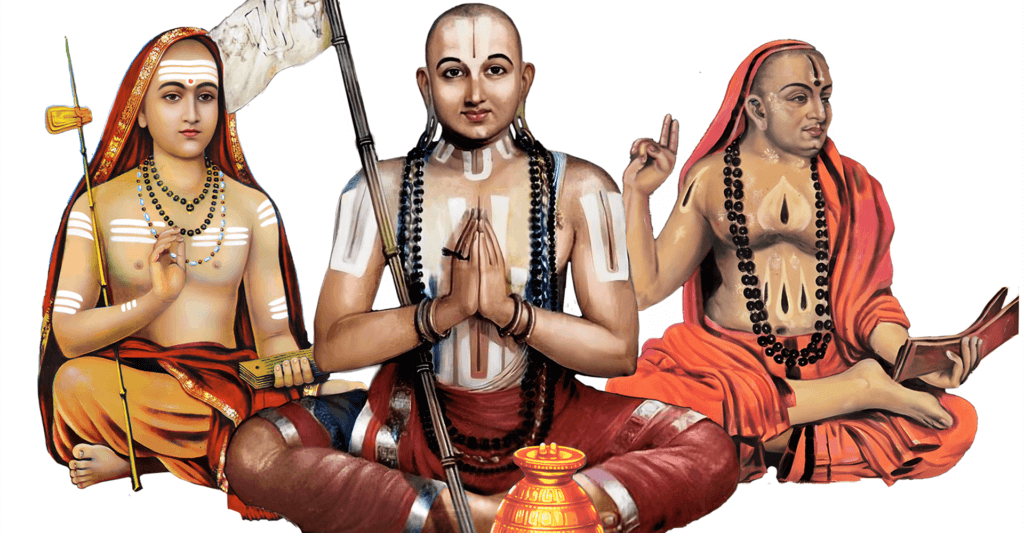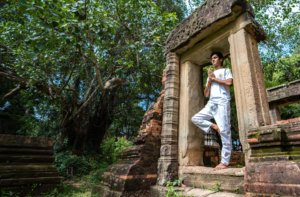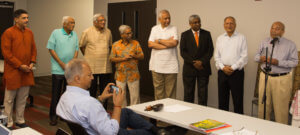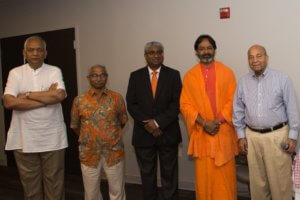
Dvaita and Viśiṣṭādvaita
Broadly speaking, the Advaita school sees the unity of Brahman, jīva, and jagat while the other two schools see Brahman separate from jīva and jagat. Let’s look at how we as average people understand the world (jagat) and Īśvara (Brahman, Lord, Kṛṣṇa, God, or identified by any similar name):
- Each one of us experiences of daily life.
- Each one of us – being a conscious being – is separate from each other.
- Each one of us – being a conscious being – is separate from other non-living beings.
- Each one of us feels that Īśvara (Brahman, Lord, Kṛṣṇa, God, or identified by any similar name) is different from us and
- Many of us believe that Īśvara created every living, and non-living being in this world (samsāra) and if we worship/become devotees of the Īśvara, our sufferings will go away.
- Many of us also believe that there is nothing called Īśvara and that whatever we see and experience in this life and world is the only reality.
- We take actions (karma) based on our likes & dislikes which generates sukha-dukkha, paap-puṇya, and multiple births.
This is largely the state of dvaita. As average people and not enlightened beings, we see the bheda (difference) while living in this world all the time. Sri Madhvācārya’s Dvaita school systematizes the bheda and so does the Viśiṣṭādvaita of Sri Rāmāṉujācārya under special conditions. Sri Madhvācārya and Sri Rāmāṉujācārya both teach that Hari (Viṣṇu) is the ultimate reality – the Īśvara – who is all-powerful, present everywhere all the time. Hari is the Brahman and is responsible for the creation, existence, and destruction of everything including us. The only difference between Dvaita and Viśiṣṭādvaita is as follows: as per Dvaita the jīva (jīvātma as a precise Vedāntic technical word) is eternal, self-illuminating, and separate from Paramātma. Each living being has a Jīvātma which means there are many Jīvātma. Viśiṣṭādvaita differs from Dvaita here and it says Jīvātma is subservient and dependent on Paramātma. As per Viśiṣṭādvaita, before the jīva gets the physical body-mind and senses, jīvātma is in a sukṣma (subtle or causal) state. In this sukṣma state, jīvātma is with Brahman. There is no bheda between jīvātma and Brahman. Once the jīvātma gets the physical body-mind-senses, it gets into the sthula state. As physical bodies are distinct from each other and have separate minds of their own the bheda (dvaita) is visible and experienced. This is the reality that we all experience in the normal state of life. The path for the jīvātma to be close to Brahman (Hari)is complete devotion through bhakti. Since the jīvātma is subservient and dependent on Brahman (Hari) a total surrender is required. In other words, humans should seek the grace of Hari through bhakti. Depending on how the devotee is offering bhakti, Hari takes care of the jīvātma after its death. Jīvātma gets a place in Vaikuntha-Loka. This is the Mukti for Jeevātma in Viśiṣṭādvaita. In the Dvaita school, the separation between the jīvātma and Brahman (Hari) remains forever. During the living life of jīvātma, the jīvātma continues to offer bhakti to Hari and seeks Mukti.
Advaita
Advaita, however, is radical in its viewpoint. It states that the bheda or dvaita that is experienced by the jīva is real though that reality is transient. This reality is called mithyā. Mithyā in today’s Indian languages means illusion or something like a mirage. In the dark, one sees the snake but upon checking it in light, realizes that it is a rope. The snake is mithyā in today’s language. However, it is not a correct representation of mithyā from Advaita’s point of view. Advaita does not consider the perceived world as something unreal or imaginary. It differentiates between Satya and mithyā. Satya for Advaita is an unchanging reality and a reality that does not depend on anything else. Mithyā is that reality that depends on something else and hence undergoes change. Once this difference between Satya and mithyā is clear the separation becomes just an incorrect understanding of reality (Satya). If we see the gold bangles, gold chain, and gold ring, each of the ornaments is separate and has its own identity. However, from Advaita’s point of view, it is just gold. The waves on the water are distinct and are real, however, waves are forms of water. Just like a wave does not exist without water, ornaments cannot exist without gold, and pots are fundamentally just clay, the jagat and jīvātma are names and forms of the Brahman. Brahman in saguṇa form is Īśvara and in the context of Bhagavad Gita chapter 11 virāṭ-rūpa is Saguna Brahman in the form of Kṛṣṇa. The unity of all jīvas and jagat is Brahman. There is no bheda (no dvaita) and hence it is advaita. The reason the world appears in dvaita is because of avidyā. Avidyā is an incorrect understanding of the human thinking that he or she is separate from the Brahman. With Jñāna (knowledge), one can realize the true nature of reality, Sat-Cit-Ānanda Ātman, and achieve Mukti. To achieve this jñāna, one needs to prepare the mind through viveka and exercising karma-yoga. This karma-yoga needs bhakti as a foundation. The more one practices karma-yoga by applying viveka in one’s life, one becomes more ardent bhakta of Īśvara.
Dvaita and Viśiṣṭādvaita are about the separation of jīva, jagat, and Īśvara. Īśvara being the all-powerful and creator, conserver, and destroyer of jīva and jagat, jīva must surrender through bhakti to seek Mukti which is a grace of Īśvara.
Advaita does not recognize the separation of jīva, jagat, and Īśvara. A bhakti-based viveka exercised through karma-yoga prepares the mind and jñāna is realized in such a mind. This realization delivers the Mukti in living the life of jīva. Such a Jīvanmukta continues to live life as per the prārabdha and once the physical body-mind-senses merge into the five elements after death, the sukṣma śarīra is merged into Īśvara.
How do we reconcile the Advaita, Viśiṣṭādvaita and Dvaita schools having apparently contradictory, opposing views of the same Upaniṣad?
देहबुद्ध्या तु दासोऽस्मि, जीवबुद्ध्या त्वदंशकः। आत्मबुद्ध्या त्वमेवाहं इति मे निश्चिता मतिः।। “Oh Lord, while I identify myself with my body, I am your servant. When I consider myself as Individual Soul, I am Your part. But when I look upon myself as the Spirit, I am one with You.”
I feel this one verse reconciles the 3 schools of Vedānta for average Hindu persons like us. All the differences in the philosophy of each school in terms of how each Ācārya has interpreted the Upaniṣad and Bhagavad Gītā are important from the deep study of each of the schools. The scriptural textual analysis and their methods of finding support in Upaniṣad and Bhagavad Gītā must be studied to gain a deeper intellectual understanding. It is not that this study is not for the average devotee. However, what matters to the average devotee is the sādhanā – the daily practice – that will pave the path of his or her Mukti. All three ācāryas’ teachings have the following common aspects:
- Īśvara is an all-pervasive, all-powerful, creator-conserver-destroyer of everything.
- Bhakti is mandatory.
- Mukti – freedom from suffering – is the goal of human life.
Despite this, how do we reconcile the apparent differences in the views of these 3 schools? I feel if we keep studying each philosophical detail of every school to compare then reconciliation is difficult. The common factors across all the 3 schools don’t yield much apart from the academic and intellectual exercise. I suggest that the 3 schools are a continuation of Vedantic thought. This continuation is evolving to explore various facets of Vedānta to simplify Hinduism for the average Hindu. Now the question is what we mean by simplification of Hinduism. Kṛṣṇa says in Bhagavad Gītā in 4.13 about गुणकर्मविभागशः – meaning He has created each person depending on their guṇas (sattva, rajas, tamas) and prārabdha karma. As he says in 2.47 about कर्मण्येवाधिकारस्ते means – one has the right to choose their karma (action) – free will to choose the actions. So, every person has predisposed guṇas and prārabdha but has free will to chart the course of life. It also means that every person has a different state of mind as a result of the combination of guṇas, prārabdha karma, and free will. Hence each person’s state of mind to be prepared to seek Mukti is different. Someone may see bheda and start the journey or someone may start with the belief that there is a unity of Self with Īśvara, or someone may start with seeing bheda but believing in unity with Īśvara. Finally, it is about the evolution of the understanding of the mind where it may start with Dvaita to Advaita or from Advaita to Dvaita or from Viśiṣṭādvaita to Advaita or Dvaita.
Advaita focuses on achieving freedom from suffering in this living life (Mokṣa). It is a path having bhakti and dhyāna at the foundation to lead a life with karmayoga which purifies the mind, and, in such a mind, “Tat Tvam Asi” is realized. Dvaita and Viśiṣṭādvaita focus on the “Sādhanā” of complete devotion – bhakti and belief that in the afterlife Hari will grace the Jīvātma with a place near him. The place that the Jīvātma gets depends on the level of devotion.
Krisha in 18.62 says तमेव शरणं गच्छ सर्वभावेन भारत। तत्प्रसादात्परां शान्तिं स्थानं प्राप्स्यसि शाश्वतम्| – “Take refuge in Him alone with your whole being, O scion of the Bhārata dynasty. Through His grace, you will attain supreme Peace and the eternal Abode.” And in 18.63 इति ते ज्ञानमाख्यातं गुह्याद्गुह्यतरं मया। विमृश्यैतदशेषेण यथेच्छसि तथा कुरु| – “To you has been imparted by Me this knowledge [Derived in the instrumental sense of ‘means of knowledge’; i.e., the scripture Gita.] which is more secret than any secret. Pondering over this, do as you like.”
Bibliography
Chari Srinivasa S. M., The Philosophy of the Bhagavadgita. A Study Based on the Evolution of the Commentaries of Sankara, Ramanuja and Madhva. New Dedlhi: Munshilala Manoharlal Publisher Pvt. Ltd., 2005.
Dutt, M. N., trans. Mahābhārata – Sanskrit Text with English Translation. 9 vols. Edited by Dr. Ishvar Chandra Sharma and Dr. O. N. Bimali. Delhi: Parimal Publications, 2018.
Radhakrishnanan S., The Bhagavadagita With and Introductory Essay, Sanskrit Text, English Translation and Notes. Noida: Harper Element, 2014.
Swami Gambhīrānanda, trans. Bhagavad Gita : With the commentary of Sankarācārya. Kolkata: Advaita Ashrama, 2018.
Swami Gambhīrānanda. Trans. Eight Upaniṣads: With the commentary of Sankarācārya. 2 vols. Kolkata: Advaita Ashrama, 2019.
Swami Dayananda Saraswati. Bhagavad Gita Home Study Course. 9 vols. Chennai: Arsha Vidya Research and Publication Trust, 2012.











3 thoughts on “Samanvaya Across 3 Vedanta Schools – Part 2”
Very concise explanation
good reading – need to read again – tks n regards n Namaskar
Not necessarily reconciliation which I believe is not necessary for the 3 schools, one of the nice one-word explanation of the philosophy I had heard is “soham, samoham & dasoham” for advaita, vishishtadvaita and dvaita (or tattvavaada) respectively,
Additionally, I believe the blog can also explore more about Bhakti, it is presented as if it is separate from Jnana, However, Madhvacharya himself describes Bhakti to be “Mahatmya Jnana…”. Madhvacharya also brought the upanishad reconciliation to veda suktas through his Rgbhasyas & explored the world of itihasas through Mahabharata Tatparya Nirnaya.
So, Hindus can continue to explore any of these schools and understand that each of these schools are comprehensive on its own & caters to all purushartas without needing the other.